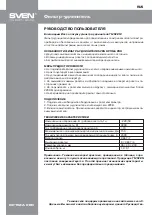
This section explains easily terms that are used with the projector and difficult terms that are not explained in the text of this guide. For details, refer
to other commercially available publications.
AMX Device Discovery
AMX Device Discovery is a technology developed by AMX to facilitate AMX control systems for easy operation of the target equipment.
Epson have implemented this protocol technology, and have provided a setting to enable the protocol function (ON).
See the AMX Web site for more details.
Aspect Ratio
(Aspect Ratio)
The ratio between an image's length and its height. HDTV images have an aspect ratio of 16:9 and appear elongated. The aspect ratio for
standard images is 4:3.
Component Video
A Video signal which has the luminance component and color component separated to provide better image quality.
Refers to images that consist of three independent signals: Y (luminance signal), Pb and Pr (color difference signals).
Composite video
Video signals that have the video brightness signals and color signals mixed together. The type of signals commonly used by household video
equipment (NTSC, PAL, and SECAM formats). The carrier signal Y (luminance signal) and chroma (color) signal that are contained in the color
bar are overlapped to form a single signal.
Contrast
The relative brightness of the light and dark areas of an image can be increased or decreased to make text and graphics stand out more clearly, or
to make them appear softer. Adjusting this particular property of an image is called Contrast adjustment.
DHCP
An abbreviation of Dynamic Host Configuration Protocol, this protocol automatically assigns an IP Address
to equipment connected to a
Network.
Dolby Digital
A sound format developed by Dolby Laboratories. Normal stereo is a 2-channel format that uses two speakers. Dolby Digital is a 6-channel
(5.1-channel) system which adds to this a center speaker, two rear speakers, and a sub-woofer.
Gateway address
(Gateway Address)
This is a server (router) for communicating across a Network (subnet) divided according to Subnet Mask
.
HDTV
An abbreviation for High-Definition Television that refers to high-definition systems which satisfy the following conditions.
•
Vertical resolution of 720p or 1080i or greater (p = Progressive
, i = Interlace
•
Screen Aspect Ratio
of 16:9
•
Dolby Digital
audio reception and playback (or output)
Interlace
A method of image scanning whereby the image data is divided into fine horizontal lines that are displayed in sequence starting from left to right
and then from top to bottom. The even-numbered lines and odd-numbered lines are displayed alternately.
IP Address
A number to identify a computer connected to a Network.
Progressive
A method of image scanning whereby the image data from a single image is scanned sequentially from top to bottom to create a single image.
Glossary
102
















































